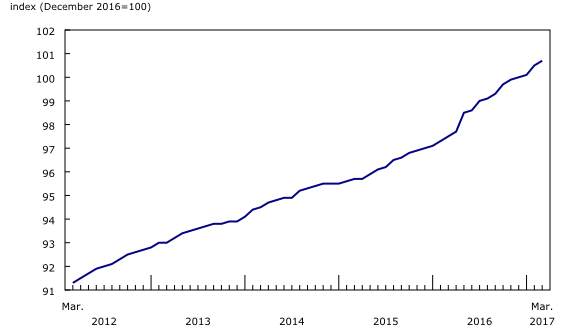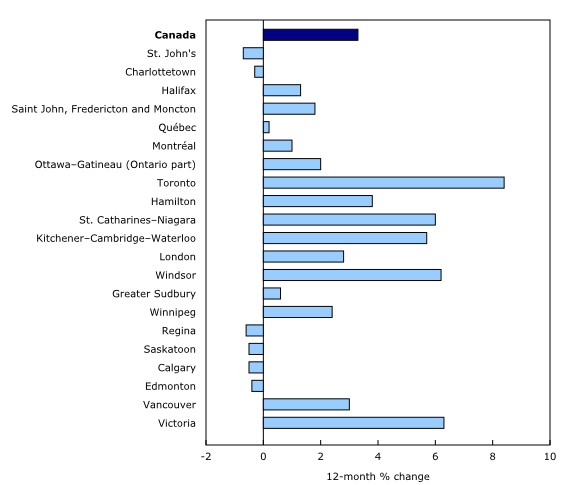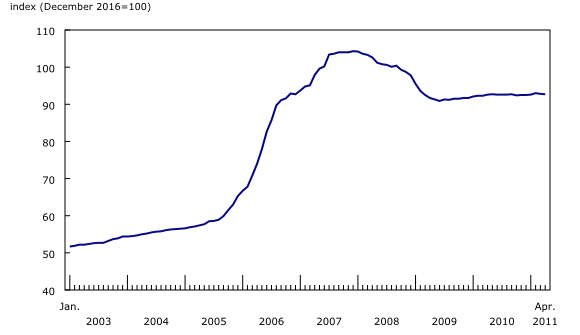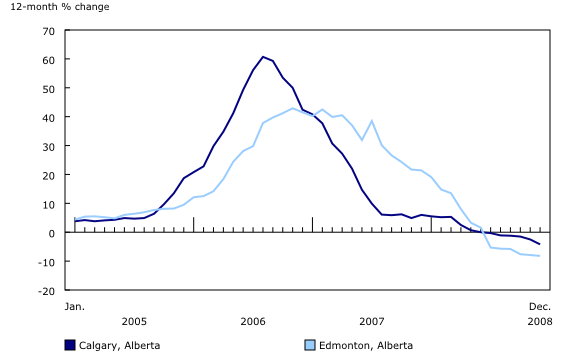New Housing Price Index, March 2017
Archived Content
Information identified as archived is provided for reference, research or recordkeeping purposes. It is not subject to the Government of Canada Web Standards and has not been altered or updated since it was archived. Please "contact us" to request a format other than those available.
Released: 2017-05-11
March 2017
0.2% 
(monthly change)
March 2017
-0.1% 
(monthly change)
March 2017
0.0%
(monthly change)
March 2017
0.0%
(monthly change)
March 2017
0.0%
(monthly change)
March 2017
-0.1% 
(monthly change)
March 2017
0.3% 
(monthly change)
March 2017
0.0%
(monthly change)
March 2017
0.0%
(monthly change)
March 2017
0.0%
(monthly change)
March 2017
0.5% 
(monthly change)
The New Housing Price Index (NHPI) rose 0.2% in March compared with the previous month. Higher new house prices in Vancouver and Toronto led the gain.
New Housing Price Index, monthly change
New house prices were up in 10 of the 27 metropolitan areas surveyed, with the largest increases in Oshawa (+1.1%) and Guelph (+0.9%). In Oshawa, builders cited higher construction costs and improving market conditions as reasons for the gain. Builders in Guelph linked higher new house prices to improving market conditions and a shortage of developed land.
Vancouver was the top contributor to the national gain, with prices up 0.7%. Builders reported market conditions as the main source of the rise. This was the first price increase in five months and the largest since May 2016.
Ottawa (+0.6%) and Windsor (+0.4%) also posted significant price gains. Builders in Ottawa reported market conditions, a shortage of developed land and higher construction costs as the key reasons for the increase, the largest since April 2011. In Windsor, builders tied the price rise to higher land development costs and improving market conditions.
In Toronto, prices edged up 0.2%, the result of favourable market conditions.
New house prices were down in three metropolitan areas and unchanged in 14.
New Housing Price Index, 12-month change
The NHPI rose 3.3% over the 12-month period ending in March, largely reflecting higher prices for new homes in Toronto (+8.4%). Other notable year-over-year increases were reported in Victoria (+6.3%), Windsor (+6.2%) and St. Catharines-Niagara (+6.0%).
In March, six metropolitan areas recorded 12-month price declines with St. John's (-0.7%) posting the largest decrease.

In celebration of the country's 150th birthday, Statistics Canada is presenting snapshots from our rich statistical history.
As part of this release on the New Housing Price Index (NHPI), we took a look back at an aspect of housing in Alberta.
During the energy boom of the mid 2000s, new housing prices in Alberta grew significantly. Starting in November 2005, builders reported 27 consecutive months of double-digit year-over-year price increases. Calgary posted the largest year-over-year NHPI gain ever recorded (+60.7%) in August 2006. Edmonton (+42.9%) saw its largest ever 12-month change in November of the same year. Price increases reflected strong demand for new housing bolstered by low unemployment, strong economic growth and an influx of workers from other provinces.
Note to readers
The New Housing Price Index (NHPI) measures changes over time in the selling prices of new residential houses agreed upon between the contractor and the buyer at the time of the signing of the contract. It is designed to measure changes in the selling prices of new houses where detailed specifications pertaining to each house remain the same between two consecutive periods.
The survey covers the following dwelling types: single dwellings, semi-detached houses and townhouses or row homes. The current value of the structure is independently indexed and is presented as the house series. The survey also collects contractors' estimates of the current value (evaluated at market price) of the land. These estimates are independently indexed to provide the published series for land. The index is available at the Canada and provincial levels, and for 27 metropolitan areas.
The prices collected from builders and included in the index are market selling prices less value-added taxes, such as the federal Goods and Services Tax or the provincial harmonized sales tax.
The index is not subject to revision and is not seasonally adjusted.
Changes to the New Housing Price Index
With the release of the January 2017 NHPI data, a number of important changes were introduced to increase the relevance of the index series. The NHPI basket was updated with new weights for the 2017 series and its coverage was expanded to include four new census metropolitan areas: Kelowna, British Columbia; Guelph, Ontario; Trois-Rivières, Quebec; and Sherbrooke, Quebec. The weights used for the 2017 series are based on a price-adjusted three-year average of the value of building completions for each metropolitan area for 2014 to 2016.
Data for periods prior to January 2017 were obtained by linking the new NHPI series, where possible, with indexes in CANSIM table 327-0046.
Separate series are now published for Toronto, Oshawa, Ottawa-Gatineau (Ontario part), Ottawa-Gatineau (Quebec part) and Greater Sudbury. The new indexes for Toronto, Ottawa and Greater Sudbury are linked to those previously published for the following combined cities: Toronto-Oshawa; Ottawa-Gatineau (Ontario/Quebec); and Greater Sudbury and Thunder Bay respectively. A combined Toronto-Oshawa index is available to users upon request for reference year 2017. Thunder Bay is no longer included in the NHPI.
The index base period, for which the NHPI equals 100, is now December 2016.
CANSIM tables 327-0046 and 327-0050 have been archived and replaced by tables 327-0056 and 327-0057 respectively.
Infographic: Producer Price Indexes at a Glance
The infographic "Producer Price Indexes at a Glance," which is part of Statistics Canada — Infographics (11-627-M), demonstrates how producer price indexes for goods and services are calculated and why they are important for the Canadian economy.
Next release
The NHPI for April will be released on June 8.
Contact information
For more information, or to enquire about the concepts, methods or data quality of this release, contact us (toll-free 1-800-263-1136; 514-283-8300; STATCAN.infostats-infostats.STATCAN@canada.ca) or Media Relations (613-951-4636; STATCAN.mediahotline-ligneinfomedias.STATCAN@canada.ca).
- Date modified:





